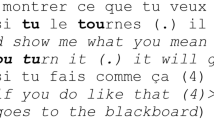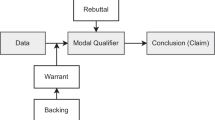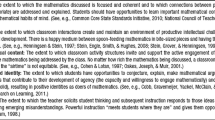Abstract
In this qualitative study of mathematical discourse between elementary teachers, we examined linguistic invention and semantic warrant production as participants made successive attempts to communicate mathematical ideas. Linguistic invention is a creative practice of describing mathematics in terms of personal experience. We introduce semantic warrant production, which emerged as part of our analysis of substantial arguments produced by teachers learning mathematics. Participants engaged in linguistic invention and semantic warrant production to convince themselves and others of the validity of their mathematical inferences about a graph of rate of change versus time. Personal experiences that are taken-as-shared in a learning community can support accurate mathematical inference if connections between conventional language, common experiences, and mathematical representations are made explicit by learners.
Similar content being viewed by others
References
Birkhoff, G. D. (2004). Intuition, reason and faith in science. In R. G. Ayoub (Ed.), Musings of the masters: An anthology of mathematical reflections (pp. 95–114). Washington, DC: The Mathematical Association of America. [Original work published 1938].
Brown, T. (2001). Mathematics education and language: Interpreting hermeneutics and post-structuralism (Rev. 2nd ed.). Dordrecht, The Netherlands: Kluwer.
Connally, E., Hughes-Hallett, D., Gleason, A. M., Cheifetz, P., Flath, D. E., Lock, P. F., Rhea, K., Swenson, C., Avenoso, F., Davidian, A., Lahme, B., Morris, J., Shure, P., Yoshiwara, K. & Marks, E. J. (1998). Functions modeling change: A preparation for calculus (preliminary ed.). New York: John Wiley & Sons.
Dienes, Z. P. (1977). Dienes on the learning of mathematics. In R. E. Reys (Ed.), Readings in secondary school mathematics (pp. 222–237). Boston: Prindle, Weber & Schmidt. [Original work published 1963].
Doerfler, W. (2000). Means for meaning. In P. Cobb, E. Yackel & K. McClain (Eds.), Symbolizing and communicating in mathematics classrooms: Perspectives on discourse, tools, and instructional design (pp. 99–131). Mahwah, NJ: Lawrence Erlbaum.
Ernest, P. (1998). The culture of the mathematics classroom and the relations between personal and public knowledge: An epistemological perspective. In F. Seeger, J. Voigh & U. Waschescio (Eds.), The culture of the mathematics classroom (pp. 245–268). New York: Cambridge University Press.
Ernest, P. (1999). Forms of knowledge in mathematics and mathematics education: Philosophical and rhetorical perspectives. Educational Studies in Mathematics, 38, 67–83.
Forman, E. A., Larreamendy-Joerns, J., Stein, M. K. & Brown, C. A. (1998). “You’re going to want to find which and prove it”: Collective argumentation in a mathematics classroom. Learning and Instruction, 8(6), 527–548.
Harel, G. & Sowder, L. (1998). Students’ proof schemes: Results from exploratory studies. CBMS Issues in Mathematics Education, 7, 234–283.
Harel, G. & Sowder, L. (2007). Toward comprehensive perspectives on the learning and teaching of proof. In F. Lester (Ed.), Second handbook of research on mathematics teaching and learning (pp. 805–842). Charlotte, NC: Information Age Inc., and National Council of Teachers of Mathematics.
Hoyles, C. (1997). The curricular shaping of students’ approaches to proof. For the Learning of Mathematics, 17(1), 7–16.
Janvier, C. (1981). Use of situations in mathematics education [Electronic version]. Educational Studies in Mathematics, 12, 113–122.
Knuth, E. (2002). Secondary school mathematics teachers’ conceptions of proof. Journal for Research in Mathematics Education, 33(5), 379–405.
Krummheuer, G. (1995). The ethnography of argumentation. In P. Cobb & H. Bauersfeld (Eds.), The emergence of mathematical meaning: Interaction in classroom cultures (pp. 229–269). Hillsdale, NJ: Lawrence Erlbaum.
Leinhardt, G., Zaslavsky, O. & Stein, M. K. (1990). Functions, graphs, and graphing; Tasks, learning, and teaching [Electronic version]. Review of Educational Research, 60(1), 1–64.
Loucks-Horsley, S., Love, N., Stiles, K. E., Mundry, S. & Hewson, P. W. (2003). Designing professional development for teachers of science and mathematics (2nd ed.). Thousand Oaks, CA: Corwin.
Moschkovich, J. (2003). What counts as mathematical discourse? In N. A. Pateman, B. J. Dougherty & J. Zilliox (Eds.), Proceedings of the 2003 joint meeting of the Group for Psychology of Mathematics Education and the North American Chapter of the Group for Psychology of Mathematics Education (vol. 3, pp. 325–331). Honolulu, HI: University of Hawaii.
Pirie, S. E. B. (1998). Crossing the gulf between thought and symbol: Language as (slippery) stepping-stones. In H. Steinbring, M. G. B. Bussi & A. Sierpinska (Eds.), Language and communication in the mathematics classroom (pp. 7–29). Reston, VA: National Council of Teachers of Mathematics.
Recio, A. M. & Godino, J. D. (2002). Institutional and personal meanings of mathematical proof. Educational Studies in Mathematics, 48, 83–99.
Rodd, M. M. (2000). On mathematical warrants: Proof does not always warrant, and a warrant may be other than a proof. Mathematical Thinking and Learning, 2(3), 221–244.
Roth, W. M. (2002). Reading graphs: Contributions to an integrative concept of literacy [Electronic version]. Journal of Curriculum Studies, 34(1), 1–24.
Toulmin, S. (1969). The uses of argument. Cambridge, UK: Cambridge University Press.
Walter, J. G. & Gerson, H. (2007). Teachers’ personal agency: Making sense of slope through additive structures. Educational Studies in Mathematics, 65(2), 203–233.
Weber, K. & Alcock, L. J. (2004). Semantic and syntactic proof productions. Educational Studies in Mathematics, 56, 209–234.
Wood, T. (1999). Creating a context for argument in mathematics class. Journal for Research in Mathematics Education, 30(2), 171–192.
Yackel, E. (2002). What we can learn from analyzing the teacher’s role in collective argumentation. Journal of Mathematical Behavior, 21, 423–440.
Yackel, E. & Cobb, P. (1996). Sociomathematical norms, argumentation, and autonomy in mathematics. Journal for Research in Mathematics Education, 27(4), 458–477.
Zevenbergen, R. (2000). Cracking the code of mathematics classrooms: School success as a function of linguistic, social, and cultural background. In J. Boaler (Ed.), Multiple perspectives on mathematics teaching and learning (pp. 201–223). Westport, CT: Ablex.
Author information
Authors and Affiliations
Corresponding author
Rights and permissions
About this article
Cite this article
Walter, J., Johnson, C. Linguistic Invention and Semantic Warrant Production: Elementary Teachers’ Interpretation of Graphs. Int J of Sci and Math Educ 5, 705–727 (2007). https://doi.org/10.1007/s10763-007-9094-7
Received:
Accepted:
Published:
Issue Date:
DOI: https://doi.org/10.1007/s10763-007-9094-7




